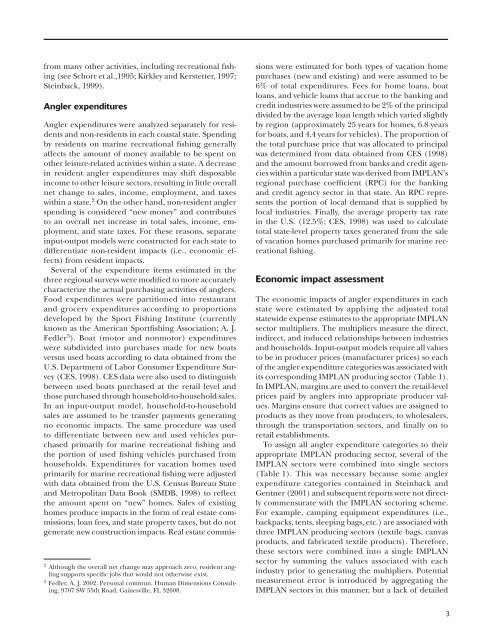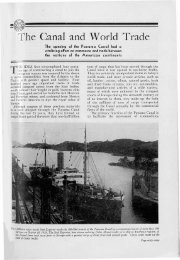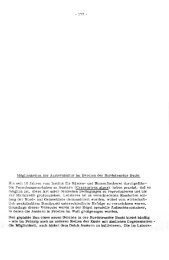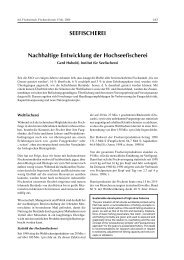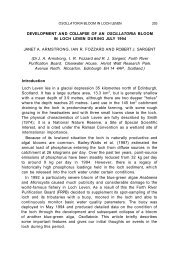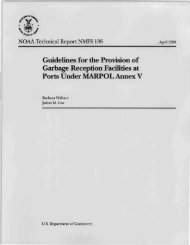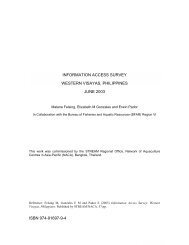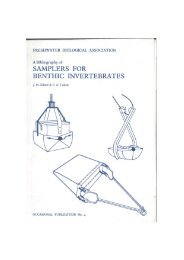The Economic Importance Of Marine Angler Expenditures In
The Economic Importance Of Marine Angler Expenditures In
The Economic Importance Of Marine Angler Expenditures In
Create successful ePaper yourself
Turn your PDF publications into a flip-book with our unique Google optimized e-Paper software.
from many other activities, including recreational fishing<br />
(see Schorr et al.,1995; Kirkley and Kerstetter, 1997;<br />
Steinback, 1999).<br />
<strong>Angler</strong> expenditures<br />
<strong>Angler</strong> expenditures were analyzed separately for residents<br />
and non-residents in each coastal state. Spending<br />
by residents on marine recreational fishing generally<br />
affects the amount of money available to be spent on<br />
other leisure-related activities within a state. A decrease<br />
in resident angler expenditures may shift disposable<br />
income to other leisure sectors, resulting in little overall<br />
net change to sales, income, employment, and taxes<br />
within a state. 2 On the other hand, non-resident angler<br />
spending is considered “new money” and contributes<br />
to an overall net increase in total sales, income, employment,<br />
and state taxes. For these reasons, separate<br />
input-output models were constructed for each state to<br />
differentiate non-resident impacts (i.e., economic effects)<br />
from resident impacts.<br />
Several of the expenditure items estimated in the<br />
three regional surveys were modified to more accurately<br />
characterize the actual purchasing activities of anglers.<br />
Food expenditures were partitioned into restaurant<br />
and grocery expenditures according to proportions<br />
developed by the Sport Fishing <strong>In</strong>stitute (currently<br />
known as the American Sportfishing Association; A. J.<br />
Fedler 3 ). Boat (motor and nonmotor) expenditures<br />
were subdivided into purchases made for new boats<br />
versus used boats according to data obtained from the<br />
U.S. Department of Labor Consumer Expenditure Survey<br />
(CES, 1998). CES data were also used to distinguish<br />
between used boats purchased at the retail level and<br />
those purchased through household-to-household sales.<br />
<strong>In</strong> an input-output model, household-to-household<br />
sales are assumed to be transfer payments generating<br />
no economic impacts. <strong>The</strong> same procedure was used<br />
to differentiate between new and used vehicles purchased<br />
primarily for marine recreational fishing and<br />
the portion of used fishing vehicles purchased from<br />
households. <strong>Expenditures</strong> for vacation homes used<br />
primarily for marine recreational fishing were adjusted<br />
with data obtained from the U.S. Census Bureau State<br />
and Metropolitan Data Book (SMDB, 1998) to reflect<br />
the amount spent on “new” homes. Sales of existing<br />
homes produce impacts in the form of real estate commissions,<br />
loan fees, and state property taxes, but do not<br />
generate new construction impacts. Real estate commis-<br />
2 Although the overall net change may approach zero, resident angling<br />
supports specific jobs that would not otherwise exist.<br />
3 Fedler, A. J. 2002. Personal commun. Human Dimensions Consulting,<br />
9707 SW 55th Road, Gainesville, FL 32608.<br />
sions were estimated for both types of vacation home<br />
purchases (new and existing) and were assumed to be<br />
6% of total expenditures. Fees for home loans, boat<br />
loans, and vehicle loans that accrue to the banking and<br />
credit industries were assumed to be 2% of the principal<br />
divided by the average loan length which varied slightly<br />
by region (approximately 25 years for homes, 6.8 years<br />
for boats, and 4.4 years for vehicles). <strong>The</strong> proportion of<br />
the total purchase price that was allocated to principal<br />
was determined from data obtained from CES (1998)<br />
and the amount borrowed from banks and credit agencies<br />
within a particular state was derived from IMPLAN’s<br />
regional purchase coefficient (RPC) for the banking<br />
and credit agency sector in that state. An RPC represents<br />
the portion of local demand that is supplied by<br />
local industries. Finally, the average property tax rate<br />
in the U.S. (12.5%; CES, 1998) was used to calculate<br />
total state-level property taxes generated from the sale<br />
of vacation homes purchased primarily for marine recreational<br />
fishing.<br />
<strong>Economic</strong> impact assessment<br />
<strong>The</strong> economic impacts of angler expenditures in each<br />
state were estimated by applying the adjusted total<br />
statewide expense estimates to the appropriate IMPLAN<br />
sector multipliers. <strong>The</strong> multipliers measure the direct,<br />
indirect, and induced relationships between industries<br />
and households. <strong>In</strong>put-output models require all values<br />
to be in producer prices (manufacturer prices) so each<br />
of the angler expenditure categories was associated with<br />
its corresponding IMPLAN producing sector (Table 1).<br />
<strong>In</strong> IMPLAN, margins are used to convert the retail-level<br />
prices paid by anglers into appropriate producer values.<br />
Margins ensure that correct values are assigned to<br />
products as they move from producers, to wholesalers,<br />
through the transportation sectors, and finally on to<br />
retail establishments.<br />
To assign all angler expenditure categories to their<br />
appropriate IMPLAN producing sector, several of the<br />
IMPLAN sectors were combined into single sectors<br />
(Table 1). This was necessary because some angler<br />
expenditure categories contained in Steinback and<br />
Gentner (2001) and subsequent reports were not directly<br />
commensurate with the IMPLAN sectoring scheme.<br />
For example, camping equipment expenditures (i.e.,<br />
backpacks, tents, sleeping bags, etc.) are associated with<br />
three IMPLAN producing sectors (textile bags, canvas<br />
products, and fabricated textile products). <strong>The</strong>refore,<br />
these sectors were combined into a single IMPLAN<br />
sector by summing the values associated with each<br />
industry prior to generating the multipliers. Potential<br />
measurement error is introduced by aggregating the<br />
IMPLAN sectors in this manner, but a lack of detailed<br />
3


